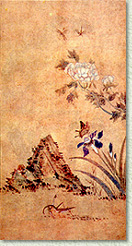
|
Min hwa is paintings drawn by the general public and through the people's demands show the simplicity and pureness. Therefore minhwa is much related to the lives of the people. These folk paintings show humor and wit. This is our cultural emotions and is not to be found in any other paintings. Min hwa expresses creativity and is free from the rules of specialized art. |
|
Varities of Min Hwa Sansoodo (Mountains and Water) Folk paintings are usually in color. Sansoodo is a drawing of mountains and either lakes, reivers, streams, or water falls. The pictures are drawn on folding screens or pasted on walls. These paintings were occasionally put where guests could easily see them. Mountains have much meaning for Koreans. Therefore it is a popular subject. |
|
Poong sok do
There are two kinds of "poongsokdo". One is "kyungjok-do" and the other is " Pyungsaengdo", "Kyungjik do" is a painting of a farming village, "Pyongsaengdo" is a painting of life starting from birth and ending in death. Life of scholars were displayed. |

|
Moonchado (Calligraphy)
This painting depicts the variations of 8 Chinese characters. The meanings are related to Confucianism. Colorful oil paints were used. |

|
|
Shashindo (Paintings of the four Gods)
The first time the four gods were painted was in the Koryo period on murals. The four gods were called "chungryong", "paekho", "choojak", and "hyunmu". In order, they were drawn in the shapes of a dragon, tiger, chicken, and a tortoise. Shipjangsaengdo (Painting of ten symbols) This drawing is of ten symbols that represent longevity. These ten symbols are the sun, the moon, clouds, water, stone, deer, tortoise, crane, pine tree, and herbs bringing eternal youth. |

|





